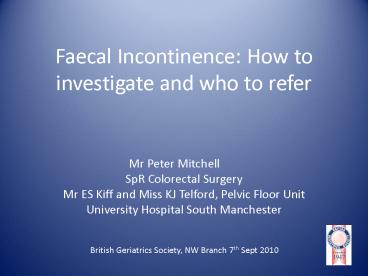Faecal Incontinence: How to investigate and who to refer - PowerPoint PPT Presentation
1 / 26
Title:
Faecal Incontinence: How to investigate and who to refer
Description:
Nursing Research 2001, 50(4) ... Digestive Diseases and Sciences 1994, 39(12) ... In such patients clearance followed by active bowel management programme maybe of ... – PowerPoint PPT presentation
Number of Views:17
Avg rating:3.0/5.0
Title: Faecal Incontinence: How to investigate and who to refer
1
Faecal Incontinence How to investigate and who
to refer
- Mr Peter Mitchell
- SpR Colorectal Surgery
- Mr ES Kiff and Miss KJ Telford, Pelvic Floor Unit
- University Hospital South Manchester
British Geriatrics Society, NW Branch 7th Sept
2010
2
Introduction
- FI - involuntary loss of stool
- FI - is a sign/symptom not a diagnosis
- Stigmatising, adverse effect on Q o L, social
restriction, significant cost to NHS - Not talked about, often neglected.
3
Incidence and prevalence ?with age
- Up to 18 of community dwelling adults1
- 1.4 of all aged gt40 2
- 47 of NH residents 3
- 3-4 of all aged gt65 4,5
Refs 1 MacMillan et al DCR 2004 2 Perry et al
Gut 2002 3 Nelson et al DCR 1998 4 Peet et al
BMJ 1995 5 Campbell et all Age Ageing 1985
4
Causes of FI - numerous!
- Your Practice
- Poor mobility
- Cognitive impairment
- Constipation
- Sphincter degeneration
- Our Practice
- Obstetric trauma
- Sphincter defect
- Iatrogenic
- Fistula
- IBS
- Inflammatory BD
- Congenital
- Both
- Prolapse
- Haemorrhoids
- Drugs
- Foods
5
Questions you must ask
- Do you have to rush?
- Stool consistency?
- Can you go when you get there?
- Does something else come out?
- Is it difficult wiping clean?
- Do you leak during the day?
6
Baseline assessment (on the ward)
- Four key bedside questions
- Have we examined and what did we find ?
- Is the patient loaded ?
- What is the stool consistency ?
- Have we excluded a cancer ?
- Commence initial treatment and then reassess
7
Doing the PR
- Two sphincters-
- IAS keeps anus closed
- EAS voluntarily squeezed to ensure closure of
anus.
8
Doing the PR - Inspection
- Anus open/closed, gapes to traction
- Poor IAS function.
9
Doing the PR - inspection
- Can you squeeze ?
- An idea of EAS function.
10
Descent/rectocele
11
Doing the PR - palpation
- Idea of resting tone.
- Idea of squeeze tone.
- Confirm if loaded or not.
- Rectocele ?
- Exclude anal/rectal cancer.
12
Treatment options
- INITIAL
- Bowel habit
- Stool consistency
- Diet and fluid intake
- Fibre
- Toilet access/mobility
- Skin preps/ pads /plugs
- Drugs cause/treat
- oral/rectal
- SPECIALISED
- Pelvic Floor Exercise
- Biofeedback
- Rectal Irrigation
- Electrical Stimulation
- Surgery
- Stoma
13
Treatment options
- Some or most of the initial treatment options may
be required. - Commence and then reassess
14
Initial treatment options
- Access?
- FI due to poor mobility
- Urgency
15
Initial treatment options
- Diet/fluid intake
- Anti-diarrhoeal medication Loperamide
- Regular, before meals (syrup or capsules)
- prn basis, imodium instants
16
Plugs
- No good evidence but may help some.
17
The faecally loaded
- Plan
- 1) initial clearance
- 2) /-bowel management programme
- Some patients restore continence with clearance.
- Those with chronic loading may benefit from
active management. - Tobin 1986 RCT
- Constipated FIlactulose and weekly enemas FI
codeine and enemas twice week - Compared with standard care significant
reduction in FI episodes.
18
Neurological /spinal injury
- muscles don't work cant go, cant hang on
- Plan
- 1) active bowel management programme
- premorbid bowel habit
- patient input/preferences
- diet/oral laxatives/evacuants to achieve
predictable bowel pattern
19
The prolapser
- Dont strain
- Soft formed stool
- Suppositories
- Plug
- Avoid constipation
20
The patient with descent / rectocele
- Digital support
- Suppositories
- Formed stool
- Enemas
- Rectal washouts
21
Who to refer?
- Failed initial options and patient keen for
further input. - Diet/fluid, Stool consistency, loperamide,
suppositories, etc. - Physically and mentally able.
- Patients with troublesome prolapse
22
Specialist Options
- Majority still managed with conservative
measures. - Biofeedback
- Surgery
- Injection bulking agents
- Anterior Sphincter repair, prolapse surgery.
- SNS
- Artificial bowel sphincter
- Stoma
23
Sacral Nerve Stimulation
24
SNS
- Mechanism of action unknown.
- Testing phase allows assessment of response.
- Easily performed under LA as daycase.
- Mainly Faecal urgency and Urge FI benefit.
- May need additional treatments.
25
Prolapse Surgery
- Abdominal Rectopexy
- Low recurrence rate
- Post op constipation
- Operative risks
- Perineal (e.g.Delormes)
- Higher recurrence rate
- Less operative risk
26
Summary
- FI is common and distressing.
- We need to talk about it.
- Baseline assessment, commence and reassess
- No one recipe for success
- Area of future research
References NICE Guidelines June 2007 Website
www.rcsed.ac.uk/fellows/kcattle/fi_home.html































